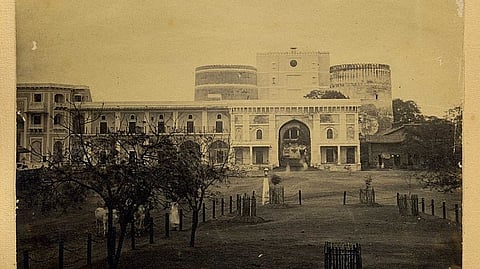The historical transformations of Ahmedabad's Bhadra Fort: From Medieval Court to British-Era Jail
Imagine standing amidst the grandeur of a fort that has witnessed the rise and fall of empires, heard the whispers of kings and held captive the hopes and fears of countless individuals. Bhadra Fort, a sentinel of history nestled in the heart of Ahmedabad is precisely such a place.
This formidable architectural masterpiece is not merely a collection of stones and walls; it is a living chronicle of the past, where the echoes of medieval courts and the somber silence of a British-era jail intermingle. As we step into the shadowed corridors of Bhadra Fort, we embark on a journey through time, uncovering the remarkable transformations that have shaped its destiny from being a seat of justice in ancient times to its haunting incarnation as a prison under British colonial rule.
Medieval Times: Bhadra Fort as a Court of Justice
The origins of Bhadra Fort can be traced back to the 15th century, during the reign of Sultan Ahmad Shah I. The sultan, who founded the city of Ahmedabad, also laid the foundation for the fort in 1411. Bhadra Fort was strategically constructed with strong defensive walls and impressive gates, showcasing the grandeur of Indo-Islamic architecture of the time.
During its early days, the fort served as a symbol of power and authority, housing the royal palaces and administrative structures. One of its notable functions was that of a court of justice. It was within these fortified walls that legal matters were deliberated upon and justice was served according to the prevailing laws of the land.
British Rule: Bhadra Fort transformed into a Jail
With the advent of the British East India Company's rule in India, the destiny of Bhadra Fort took a different turn. The British recognized the strategic importance of the fort and its central location, and subsequently, repurposed it to suit their administrative and control needs.
During the British colonial era, Bhadra Fort underwent a transformation that turned it into a jail. The once-majestic royal palaces were adapted to house prisoners and the courtrooms witnessed a shift from legal deliberations to the implementation of British rule. The fort's formidable walls, once designed to protect the city from external threats, now confined those who resisted British authority.
Preservation and Legacy
Despite these transformations, Bhadra Fort retained its historical significance and architectural splendor. Over the years, efforts have been made to preserve and restore this iconic structure. The fort's intricate carvings, spacious courtyards and splendid architecture continue to draw history enthusiasts and tourists alike, offering a glimpse into the dynamic past of Ahmedabad.
Today, Bhadra Fort stands as a living embodiment of the city's journey through time. Its walls echo the voices of medieval courts and British-era prisoners, reflecting the ever-changing socio-political landscape of India. As visitors explore the corridors and ramparts of the fort, they are transported to eras that have shaped the destiny of not just Ahmedabad, but the entire nation.
To get all the latest content, download our mobile application. Available for both iOS & Android devices.

